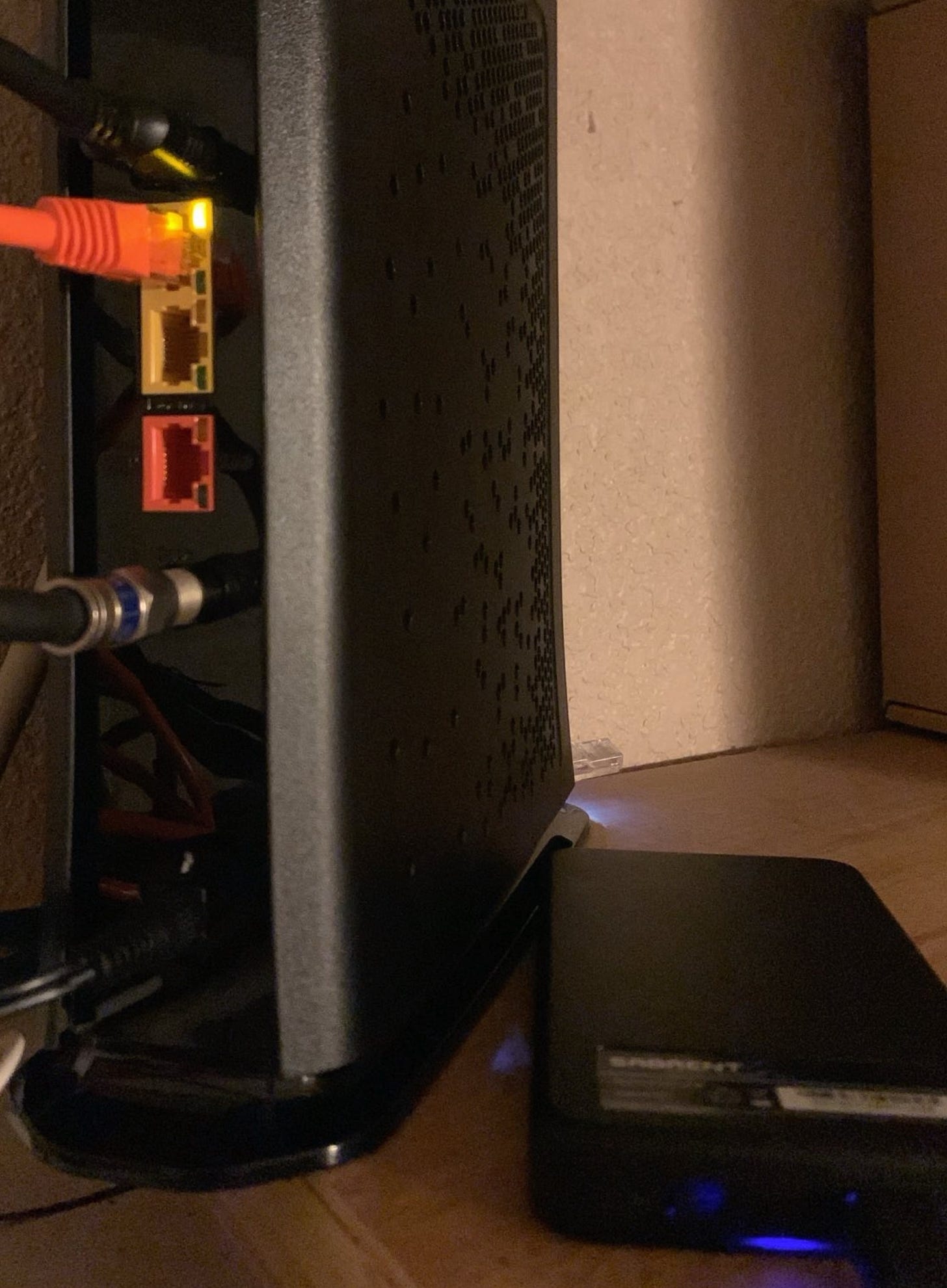One of the people I work for here in the East Bay recently switched to Astound for their service and received a Hitron Coda 5712 cable modem. They noticed that it’s got a USB port in back and the manual mentions file sharing, so I was engaged to get this going. The documentation is nonexistent - the official Coda 5712 page offers two small files, neither cover the sharing function. I think this is one of those “provider does not support” features, which makes me wonder about it’s stability/utility.
I went after it, got it running using a Raspberry Pi5, the tshark protocol analyzer, and an external USB. I see a lot of folks who are not unix genies rubbing that thing, trying to get it work, so I’ll share the particulars …
Coda 5712:
So that’s the back of a Coda 5712. Starting from the bottom, there’s a barrel connector, a coaxial cable link, the orange RJ-45 is 2.5G ethernet, the yellow ones are 1G, and it’s hard to see but there’s a USB 3.0 port above that, which is connected to the Sabrent external drive. About two inches above that there’s a finger sized dimple - the WPS button. You might find documentation for other devices that says it’s a USB 2.0 port, I did notice that during my travels, but this one is definitely USB 3.0 - has the little blue tab inside, not black.
The bottom label of the machine has everything you need to know - default username cusadmin, password is same as your wifi network, system IP is 192.168.0.1. If you inherit one and need to factory reset I’m not sure what that procedure is, but the label also includes the default WiFi network it offers, and it’ll just wake up ready to get configured via https://192.168.0.1.
This is what you’ll find if you access the machine with nothing plugged into USB.
And this is what the Help button gives you
Sharing:
The manual page I saw, which I am not able to relocate, was utter junk - “plug in a drive, now you’ve got sharing”. They clearly hired an underpants gnome to write this. The Help button is the best thing going in terms of information.
What I discovered by trial and error with Ubuntu on a Pi 5, tshark sniffer, and experience with SMB going back to LANtastic is this:
You’ll need some tools from Samba, so go ahead and install this - samba-common, samba-common-bin, and samba-libs got me a working /usr/bin/smbclient. There are ways to mount stuff using Samba but I am old and grouchy, so I installed cifs-utils.
Various clues along the way, mostly from Reddit posts of people who almost got it working, provided me with guidance. Other models of Coda devices expect the USB device to have an MBR setup. I used fdisk and did something like you see here. This isn’t the actual drive, it’s a junk 8GB USB 2 thumb drive I had sitting around that I’m using to make screen shots for you.
Once that was done, I tried to access it and I got this - the Coda system probably uses Samba as part of its software for sharing, and the SMB1 disabled is an issue. I messed around with this for a long time, then I found another page on Reddit from some other person who gave up, and it mentioned a connection between partition names and shares.
I split the drive into two partitions, one type “b” and the other type “c”. There are about a dozen different Windows partition formats in Linux fdisk, each of which I hate more than all the rest combined. Those two seemed the least useless to me. Once I created /dev/sda1 and /dev/sda2, formatted them using mkfs -t vfat, smbclient client sees the following:
But this is still the best you’re gonna get out of the Coda 5712 - same thing as it says when you have an MBR drive in with no partitions. It has no idea it’s offering sda1 and sda2.
But here we are, with a working share … as long as you’re a unix genie who can do this:
mount -t cifs '\192.168.0.1\sda1' /nas -o username=cusadmin,password=oRgAsMaTrOn
But then I contrived a bandwidth test and I can guess why this is not a supported feature … it’ll converge on a 6.5 megabyte/sec transfer rate if you have a big file. If you tried to stream movies from a connected USB device you might do OK … until the minute someone else does ANYTHING with this network, then it’s Max Headroom time.
Conclusion:
If I had a Coda 5712 I’d probably come up with some reason to leave a thumb drive in it, a bolt hole for small random files. Or I’d spend some time playing with drive formats, see if I could find one that made full use of the gigabit network port’s bandwidth.
But when I get down to dealing with crap like this, and it’s not my crap, I’m just gonna tell the user to get a purpose built SAN with decent support.











